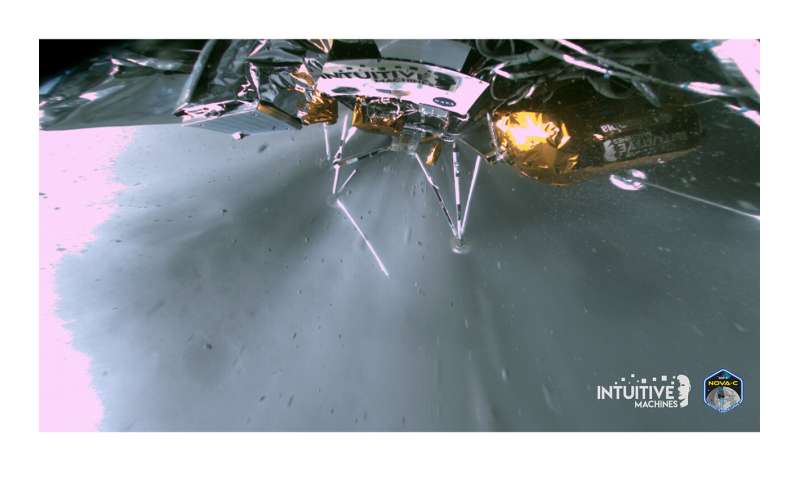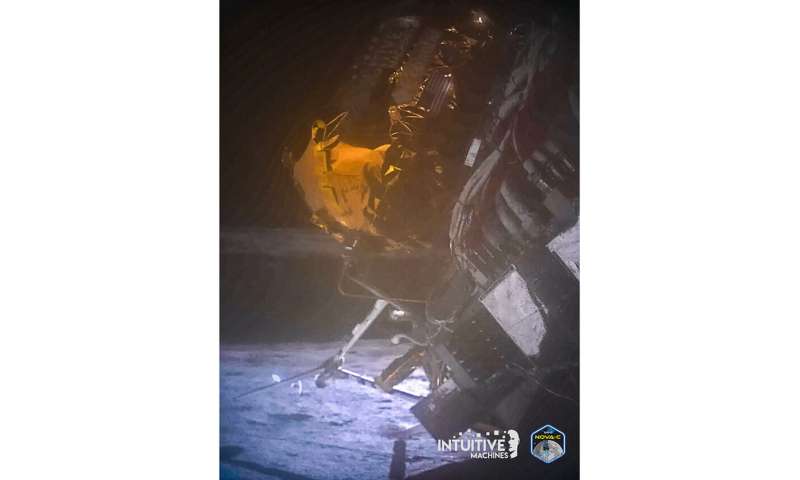The first U.S. spacecraft to land on the moon since the Apollo astronauts fell silent Thursday, a week after breaking a leg at touchdown and tipping over near the lunar south pole.
Intuitive Machines’ lander, Odysseus, lasted longer than the company anticipated after it ended up on its side with hobbled solar power and communication.
The end came as flight controllers received one last photo from Odysseus and commanded its computer and power systems to standby. That way, the lander can wake up in another two to three weeks—if it survives the bitterly cold lunar night. Intuitive Machines spokesman Josh Marshall said these final steps drained the lander’s batteries and put Odysseus “down for a long nap.”
“Good night, Odie. We hope to hear from you again,” the company said via X, formerly Twitter.
Before losing power, Odysseus sent back what Intuitive Machines called “a fitting farewell transmission.”
Taken just before touchdown, the picture shows the bottom of the lander on the moon’s pockmarked surface, with a tiny crescent Earth and a small sun in the background.
The lander was originally intended to last about a week at the moon.
Houston-based Intuitive Machines became the first private business to land a spacecraft on the moon without crashing when Odysseus touched down Feb. 22. Only five countries had achieved that since the 1960s, including Japan, which made a sideways landing last month.
-

This image provided by Intuitive Machines shows a broken landing leg on the Odysseus lander. The lander touched down near the moon’s south pole on Feb. 22, 2024, but then fell over on its side, hampering communications. Credit: Intuitive Machines via AP
-

This image provided by Intuitive Machines taken on Tuesday, Feb. 27, 2024, shows flight controllers commanding the Odysseus lunar lander to capture a new image using its narrow-field-of-view camera. After successfully transmitting the image to Earth, flight controllers received additional insight into Odysseus’ position on the lunar surface. Credit: Intuitive Machines via AP
Odysseus carried six experiments for NASA, which paid $118 million for the ride. The first company to take part in NASA’s program for commercial lunar deliveries never made it to the moon; its lander came crashing back to Earth in January.
NASA views these private landers as scouts that will pave the way for astronauts due to arrive in another few years.
Until Odysseus, the last U.S. moon landing was by Apollo 17’s Gene Cernan and Harrison Schmitt in 1972.
© 2024 The Associated Press. All rights reserved. This material may not be published, broadcast, rewritten or redistributed without permission.
Citation:
First US moon lander in half a century stops working a week after tipping over at touchdown (2024, March 1)
retrieved 1 March 2024
from
This document is subject to copyright. Apart from any fair dealing for the purpose of private study or research, no
part may be reproduced without the written permission. The content is provided for information purposes only.